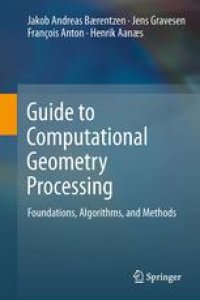
Ebook: Guide to computational geometry processing: foundations, algorithms, and methods
- Tags: Math Applications in Computer Science, Symbolic and Algebraic Manipulation, Computer Graphics, Artificial Intelligence (incl. Robotics), Image Processing and Computer Vision, Computer-Aided Engineering (CAD CAE) and Design
- Year: 2012
- Publisher: Springer-Verlag London
- City: London ; New York
- Edition: 1
- Language: English
- pdf
This book reviews the algorithms for processing geometric data, with a practical focus on important techniques not covered by traditional courses on computer vision and computer graphics. Features: presents an overview of the underlying mathematical theory, covering vector spaces, metric space, affine spaces, differential geometry, and finite difference methods for derivatives and differential equations; reviews geometry representations, including polygonal meshes, splines, and subdivision surfaces; examines techniques for computing curvature from polygonal meshes; describes algorithms for mesh smoothing, mesh parametrization, and mesh optimization and simplification; discusses point location databases and convex hulls of point sets; investigates the reconstruction of triangle meshes from point clouds, including methods for registration of point clouds and surface reconstruction; provides additional material at a supplementary website; includes self-study exercises throughout the text.
Optical scanning is rapidly becoming ubiquitous. From industrial laser scanners to medical CT, MR and 3D ultrasound scanners, numerous organizations now have easy access to optical acquisition devices that provide huge volumes of image data. However, the raw geometry data acquired must first be processed before it is useful. This Guide to Computational Geometry Processing reviews the algorithms for processing geometric data, with a practical focus on important techniques not covered by traditional courses on computer vision and computer graphics. This is balanced with an introduction to the theoretical and mathematical underpinnings of each technique, enabling the reader to not only implement a given method, but also to understand the ideas behind it, its limitations and its advantages. Topics and features: * Presents an overview of the underlying mathematical theory, covering vector spaces, metric space, affine spaces, differential geometry, and finite difference methods for derivatives and differential equations * Reviews geometry representations, including polygonal meshes, splines, and subdivision surfaces * Examines techniques for computing curvature from polygonal meshes * Describes algorithms for mesh smoothing, mesh parametrization, and mesh optimization and simplification * Discusses point location databases and convex hulls of point sets * Investigates the reconstruction of triangle meshes from point clouds, including methods for registration of point clouds and surface reconstruction * Provides additional material at a supplementary website * Includes self-study exercises throughout the text Graduate students will find this text a valuable, hands-on guide to developing key skills in geometry processing. The book will also serve as a useful reference for professionals wishing to improve their competency in this area.
Part 1. Mathematical Preliminaries -- Vector Spaces, Affine Spaces, and Metric Spaces -- Differential Geometry -- Finite Difference Methods for Partial Differential Equations -- Introduction -- Part 2. Computational Geometry Processing -- Polygonal Meshes -- Splines -- Subdivision -- Curvature in Triangle Meshes -- Mesh Smoothing and Variational Subdivision -- Parametrization of Meshes -- Simplifying and Optimizing Triangle Meshes -- Spatial Data Indexing and Point Location -- Convex Hulls -- Triangle Mesh Generation: Delaunay Triangulation -- 3D Surface Registration via Iterative Closest Point (ICP) -- Surface Reconstruction using Radial Basis Functions -- Volumetric Methods for Surface Reconstruction and Manipulation -- Isosurface Polygonization